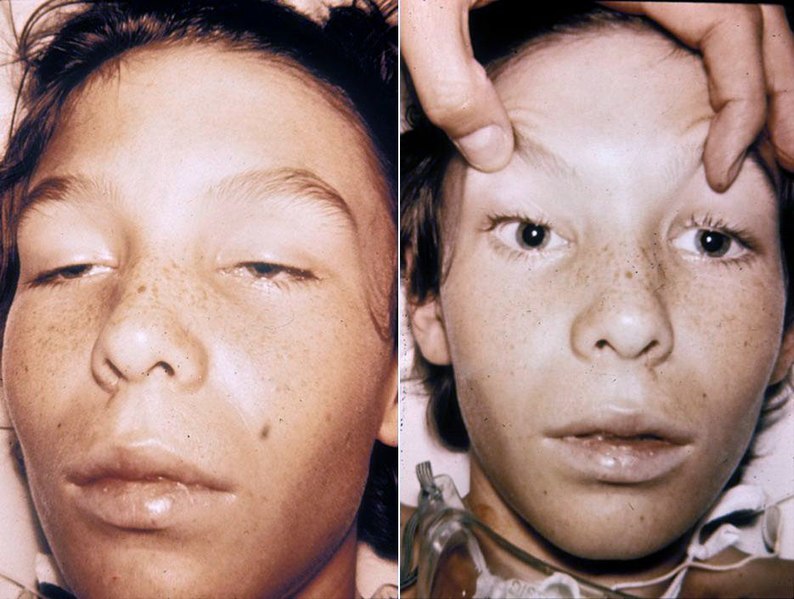Playlist
Show Playlist
Hide Playlist
Botulinum Toxin Toxicity: Pathophysiology and Treatment
-
Slides Strowd Infectious NMJ Disorders.pdf
-
Download Lecture Overview
00:01 So what's going on? What causes weakness or this junctional disorder in patients with botox toxicity or botulism, presenting with botulism? Here we're going to look very closely at the neuromuscular junction. 00:14 We see that the nerve is ending on the top of the muscle and as we zoom in we look at the neuromuscular junction. 00:22 And we see the key pieces that are that are required for neuromuscular junction transmission. 00:27 Acetylcholine is contained within the synaptic vesicles and in order for muscle contraction to occur, it must move down the presynaptic membrane down the nerve bind to the presynaptic terminus, release acetylcholine, acetylcholine must bind to its receptor and this drives end plate potential, muscle depolarization and contraction, and there are key proteins that are involved in that process, and they're called the snap and the snare proteins. 00:55 And you can see those highlighted here. 00:57 The snare and snap proteins help to move the synaptic vesicle to the terminus. 01:03 They bind together, bring the vesicle down to the terminus and help it to bind to the presynaptic terminus and release acetylcholine. 01:11 Botulism involves an impairment in this signaling cascade. 01:17 So what happens? Well botulism ,the botulism toxin is composed of both a heavy chain and a light chain. 01:24 The heavy chain when ingested, the heavy chain helps to bind the toxin to the presynaptic membrane. 01:32 As a result of binding that protein complex is endocytosed into the nerve terminus and we can see that happening here in this figure. 01:42 The light chain then moves out of the vesicle traffics to where the snap and snare proteins are and degrades the snap and snare proteins. 01:51 The presynaptic vesicle is unable to bind to the membrane, acetylcholine is not able to be released. 01:57 Acetylcholine cannot drive end plate potential and muscles cannot contract, and patients present with prominent weakness. 02:04 So here we see the treatments for iatrogenic botulism and there's four things we think about. 02:09 The first and most important is withdraw of the offending agent or ingestion, that's what's caused this disorder and the treatment of choice is withdrawal. 02:18 In some cases, we can think about administration of the botulism antitoxin. 02:24 Pyridostigmine is a symptomatic management, which we can utilize in botulism and can help in selected cases and then really supportive care is critical for these patients.
About the Lecture
The lecture Botulinum Toxin Toxicity: Pathophysiology and Treatment by Roy Strowd, MD is from the course Disorders of the Neuromuscular Junctions.
Included Quiz Questions
Which of the following best characterizes the mechanism of botulism toxicity?
- Botulinum toxin acts as a protease and cleaves SNARE proteins which are required for the binding of the presynaptic vesicle to the nerve membrane.
- Botulinum toxin acts as a phospholipase that degrades the vesicle containing the neurotransmitter.
- Botulinum toxin binds to ACh receptors and acts as a competitive inhibitor preventing muscle contraction.
- Botulinum toxin blocks presynaptic calcium channels preventing synaptic depolarization.
- Botulinum toxin augments the reuptake of ACh in the synaptic cleft resulting in decremental response with repetitive action.
Which of the following is not a treatment of iatrogenic botulism?
- Broad-spectrum antibiotic therapy
- Withdrawal of offending agent or ingestion
- Antitoxin
- Pyridostigmine
- Supportive care
Customer reviews
5,0 of 5 stars
| 5 Stars |
|
5 |
| 4 Stars |
|
0 |
| 3 Stars |
|
0 |
| 2 Stars |
|
0 |
| 1 Star |
|
0 |




